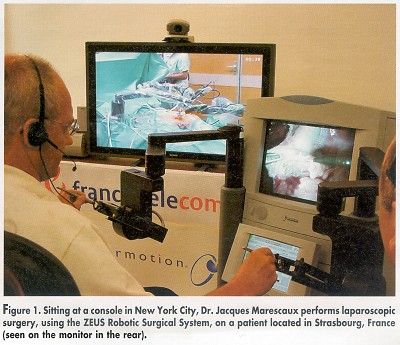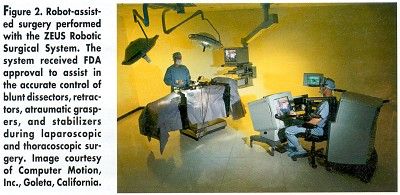Surgeons in New York Operate on Patient in France
NEW YORK-Researchers reported in the September 27 Nature that a surgeon on one side of the Atlantic removed the gallbladder of a patient on the other side, but the clinical usefulness of this long-distance, robot-assisted laparoscopic surgery is uncertain.
NEW YORKResearchers reported in the September 27 Nature that a surgeon on one side of the Atlantic removed the gallbladder of a patient on the other side, but the clinical usefulness of this long-distance, robot-assisted laparoscopic surgery is uncertain.
This report shows that robot-assisted laparoscopy can be stretched between remote sites, but major problems remain to be resolved, including high equipment cost, absence of tactile feedback, and incomplete availability of the high-speed, broad-bandwidth telecommunications needed to transmit images over distance without irritating and potentially dangerous time delays.
Lead author Jacques Marescaux, MD, of the Department of Digestive Surgery, University of Strasbourg, France, reported that, following six laparoscopic remote robotic cholecystectomies in pigs, the procedure was successfully carried out in a 68-year-old female patient.
Dr. Marescaux and two other surgeons directed the robotic console at the GlobalOne Building in New York City where a high-speed fiberoptic network was available.

Two surgeons with the patient in Strasbourg set up the trocar position and were on hand to stop the robot if things went awry. Coagulation was coordinated by voice between the two sites.
The total time lag was 155 ms, well below the 330 ms limit judged safe by surgeons in previous studies. Setting up the apparatus took 16 minutes, and the gallbladder was dissected in 54 minutes with no intraoperative or postoperative complications. The patient was discharged 48 hours after surgery.
"We showed that dissection of an artery, dissection of a biliary canal, and ablation of an organ can be done safely by robot-assisted laparoscopy guided by a surgeon at a remote site," Dr. Marescaux told ONI. "The time delay of 155 ms is acceptable and allows the surgeon’s brain to adapt immediately."
The Set-Up
The basic set-up for robot-assisted laparoscopy includes the surgeon’s viewing and control console and the surgical arm unit that positions and maneuvers detachable surgical instruments. The Marescaux group used the ZEUS Robotic Surgical System (Computer Motion, Goleta, California), which was approved on October 9, 2001, by the FDA for sale in the United States

.
A similar system, the da Vinci robot (Intuitive Surgical, Mountain View, California) had been FDA approved for clinical intra-abdominal use.
Robotic laparoscopic surgery was developed to improve surgeon dexterity and allow more precise control of instruments. The directing surgeon controls movements of the camera by vocal commands and movements of the two operating instruments by joysticks.
Translation and rotation can be adjusted throughout the procedure. For example, if translation is set at 3 to 1, when the operator moves his hand by 3 cm, the robotic arm moves the instrument by only 1 cm. The trans-Atlantic set-up just increased the distance between the control console and the robotic arms.
Co-author Steven Butner, PhD, told ONI that the transatlantic set-up involved dividing a standard ZEUS into two parts, shipping the "arms" to France, setting up the "console" in New York, and inserting computers at each end to manage communication over the dedicated line.
"The virtual circuit contributed by France Telecom at 10 megabits was probably higher quality than is actually needed, and I expect we will see this experiment repeated using less bandwidth," said Dr. Butner, professor of electrical and computer engineering, University of California, Santa Barbara. He pointed out that the bandwidth is needed not to relay the communications signals for the robot but to provide the very high quality video the surgeons want.
The only study comparing robot-assisted laparoscopic surgery (not performed remotely) with conventional laparoscopic surgery was reported earlier this year by Bertrand Guillonneau, MD, and his colleagues at University Pierre and Marie Curie in Paris. They compared results for pelvic lymph node dissections for prostate cancer staging in 10 patients using robotic surgery and 10 patients using conventional laparoscopic surgery.
Dr. Guillonneau concluded that the robotic approach was safe, feasible, and as accurate as conventional laparoscopic surgery but provided "no actual advantage for the patient." It took longer (125 minutes vs 60 minutes), although time decreased as surgeons gained experience.
Robot-assisted telesurgery would appear to be useful for providing input from a distant surgeon with expertise needed in a particular case, but the technology seems unlikely to provide much help for remote, surgically underserved regions. The ZEUS and da Vinci robots cost between $750,000 and $1 million, and additional funds would be needed for the high-bandwidth connection.
Michel Gagner, MD, of Mt. Sinai Medical Center, one of the surgeons in New York who took part in the surgery, told ONI that the main barriers to be overcome before robotic telesurgery will be accepted as standard practice include reducing the cost of equipment, resolving ethical and legal questions such as medical licensing between states, achieving widespread installation of fiberoptic networks, and providing medical engineering backup.
Dr. Gagner also raised a deeper issue. "Philosophically, robot-assisted telesurgery creates a large distance between the patient and the physician, perhaps contributing to the dehumanization of medicine," he said.